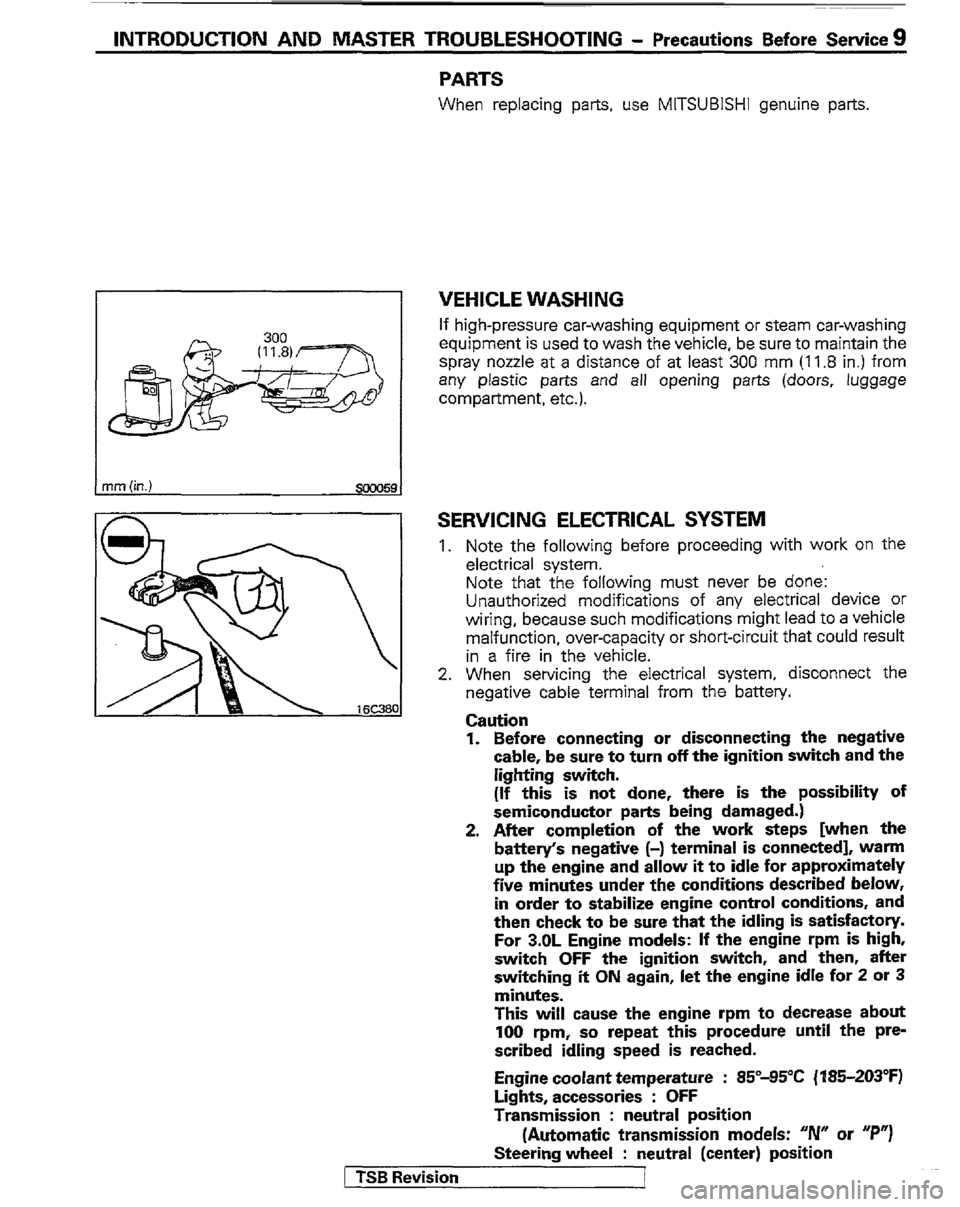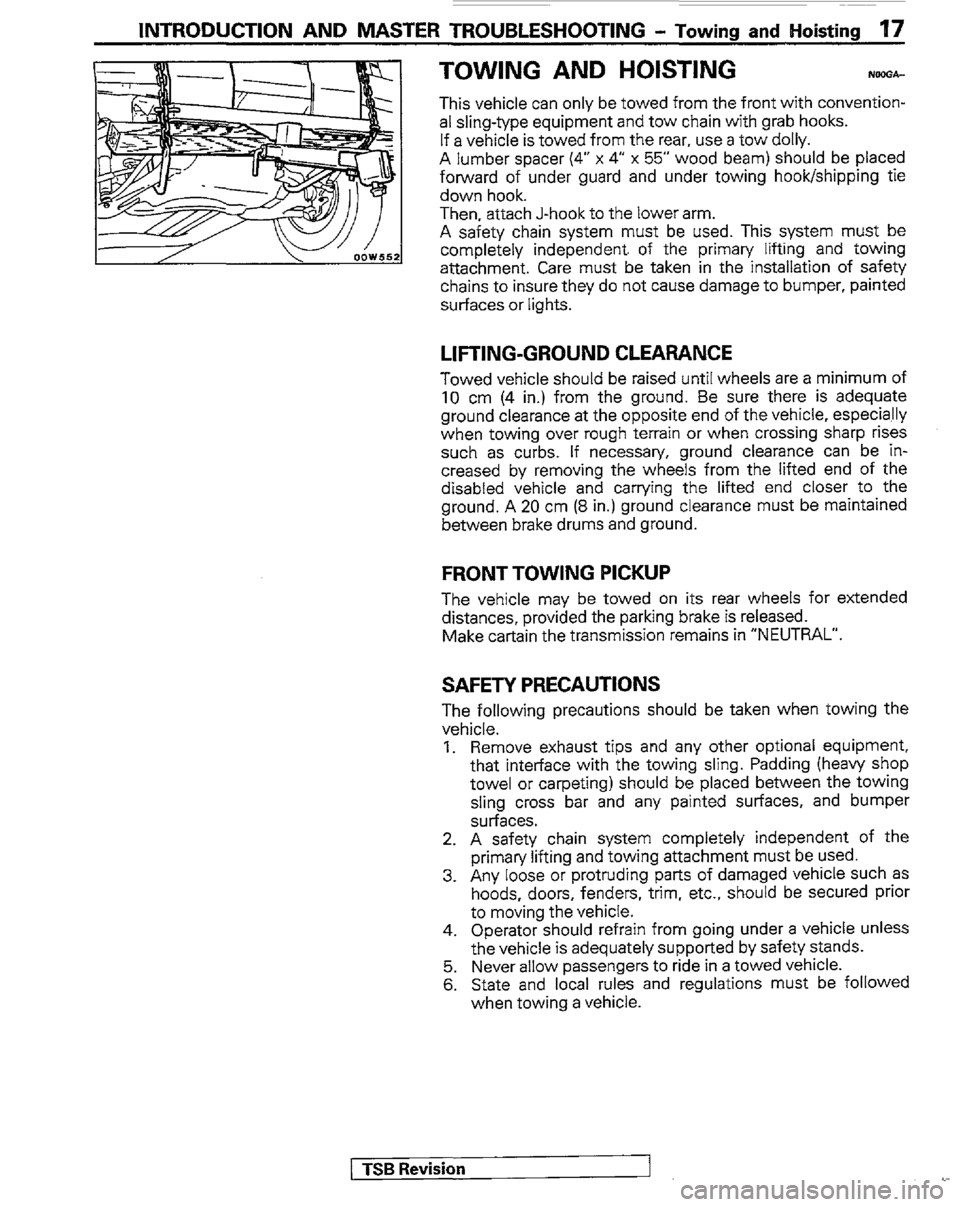light MITSUBISHI MONTERO 1989 1.G Workshop Manual
[x] Cancel search | Manufacturer: MITSUBISHI, Model Year: 1989, Model line: MONTERO, Model: MITSUBISHI MONTERO 1989 1.GPages: 30, PDF Size: 1.61 MB
Page 9 of 30

INTRODUCTION AND MASTER TROUBLESHOOTING - Precautions Before Service 9
nm (in.)
smo59
PARTS
When replacing parts, use MITSUBISHI genuine parts
VEHICLE WASHING
If high-pressure car-washing equipment or steam car-washing
equipment is used to wash the vehicle, be sure to maintain the
spray nozzle at a distance of at least 300 mm (11.8 in.) from
any plastic parts and all opening parts (doors, luggage
compartment, etc.).
SERVICING ELECTRICAL SYSTEM
1. Note the following before proceeding with work on the
electrical system.
Note that the following must never be done:
Unauthorized modifications of any electrical device or
wiring, because such modifications might lead to a vehicle
malfunction, over-capacity or short-circuit that could result
in a fire in the vehicle.
2. When servicing the electrical system, disconnect the
negative cable terminal from the battery.
Caution
1. Before connecting or disconnecting the negative
cable, be sure to turn off the ignition switch and the
fighting switch.
(If this is not done, there is the possibility of
semiconductor parts being damaged.)
2. After completion of the work steps [when the
battery’s negative (-) terminal is connected], warm
up the engine and allow it to idle for approximately
five minutes under the conditions described below,
in order to stabilize engine control conditions, and
then check to be sure that the idling is satisfactory.
For 3.OL Engine models: If the engine rpm is high,
switch OFF the ignition switch, and then, after
switching it ON again, let the engine idle for 2 or 3
minutes.
This will cause the engine rpm to decrease about
100 rpm, so repeat this procedure until the pre-
scribed idling speed is reached.
Engine coolant temperature : 85”-95°C (‘l85403”F)
Lights, accessories : OFF
Transmission : neutral position
(Automatic transmission models: “IV or “P”J
Steering wheel : neutral (center) position
1 TSB Revision
Page 17 of 30

INTRODUCTION AND MASTER TROUBLESHOOTING - Towing and Hoisting 17
TOWING AND HOISTING
This vehicle can only be towed from the front with convention-
al sling-type equipment and tow chain with grab hooks.
If a vehicle is towed from the rear, use a tow dolly.
A lumber spacer (4” x 4” x 55” wood beam) should be placed
forward of under guard and under towing hook/shipping tie
down hook.
Then, attach J-hook to the lower arm.
A safety chain system must be used. This system must be
completely independent. of the primary lifting and towing
attachment. Care must be taken in the installation of safety
chains to insure they do not cause damage to bumper, painted
surfaces or lights.
LIFTING-GROUND CLEARANCE
Towed vehicle should be raised until wheels are a minimum of
10 cm (4 in.) from the ground. Be sure there is adequate
ground clearance at the opposite end of the vehicle, especially
when towing over rough terrain or when crossing sharp rises
such as curbs. If necessary, ground clearance can be in-
creased by removing the wheels from the lifted end of the
disabled vehicle and carrying the lifted end closer to the
ground. A 20 cm (8 in.) ground clearance must be maintained
between brake drums and ground.
FRONT TOWING PICKUP
The vehicle may be towed on its rear wheels for extended
distances, provided the parking brake is released.
Make cartain the transmission remains in “NEUTRAL”.
SAFETY PRECAUTIONS
The following precautions should be taken when towing the
vehicle.
1. Remove exhaust tips and any other optional equipment,
that interface with the towing sling. Padding (heavy shop
towel or carpeting) should be placed between the towing
sling cross bar and any painted surfaces, and bumper
surfaces.
2. A safety chain system completely independent of the
primary lifting and towing attachment must be used.
3. Any loose or protruding parts of damaged vehicle such as
hoods, doors, fenders, trim, etc., should be secured prior
to moving the vehicle.
4. Operator should refrain from going under a vehicle unless
the vehicle is adequately supported by safety stands.
5.
Never allow passengers to ride in a towed vehicle.
6. State and local rules and regulations must be followed
when towing a vehicle.
1 TSB Revision